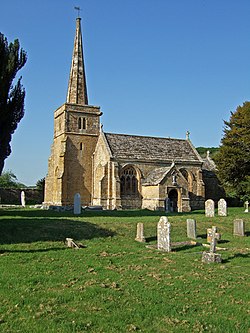Compton Paunchfoot
| Compton Pauncefoot | |
| Somerset | |
|---|---|
 St Mary, Compton Paunchfoot | |
| Location | |
| Grid reference: | ST645265 |
| Location: | 51°2’12"N, 2°30’27"W |
| Data | |
| Population: | 139 (2011) |
| Post town: | Yeovil |
| Postcode: | BA22 |
| Dialling code: | 01963 |
| Local Government | |
| Council: | Somerset |
| Parliamentary constituency: |
Somerton and Frome |
Compton Pauncefoot is a village in Somerset, siting beside the A303 road five miles south-west of Wincanton. There are approximately 35 houses in the village of Compton Pauncefoot and a similar number in neighbouring Blackford: the two counted together as a parish had a population recorded as 139 in 2011.
The village is a designated Conservation Area.
History
The name of the village is believed to come from cumb tun: 'valley village', with a suffix to indicate manorial ownership by a knight named Pauncefote ('Fat-bellied').
Baron Blackford, of Compton Pauncefoot in the County of Somerset, was a title in the Peerage of the United Kingdom. It was created in 1935 for the barrister William Mason. He had already been created a Baronet, of Compton Pauncefoot in the County of Somerset, in the Baronetage of the United Kingdom in 1918. The titles became extinct in 1988 on the death of his great-grandson, the fourth Baron.
Geography
The stream through Compton Pauncefoot is a tributary of the River Cam, Somerset. It flows under the A303 to join the Yarlington headwaters. The Cam flows onto the Royal Naval Station where it joins the River Yeo, a tributary of the River Parrett.
Parish church
The parish church, St Mary, dates from the 15th century and is built of hamstone. In 1485 Sir Walter Pauncefoot left money for the building of the church and for a chantry at Compton Pauncefoot, where a priest could pray daily for his soul and for those of his immediate family. He also left several yards of differently coloured silks to be made into vestments.
Until 1864 the church comprised a nave with south aisle and porch, and a tower at the west. The inner arches of the tower carried a spire of graceful proportions. The north aisle was added in 1864, and at the same time the two stone coffins (now in the churchyard by the yew tree) were removed.
The font is 13th-century and is perfectly plain. There is a mass dial on the south wall. The frieze in the south aisle has part of a stone inscribed "Anne Whyting 1535." In the wall under the sill of the adjacent window is a long stone panel divided into compartments, each containing a shield bearing coats of arms relating to the Whyting and Pauncefoot families.
The church is a Grade II* listed building.[1]
About the village

Compton Castle was built for John Hubert Hunt about 1825,[2] in a Gothic style with large grounds, gatehouse, and lawns stretching down to a lake.[2]

The Old Rectory has Georgian, additions to an earlier building.[3] Recently this house and the church were used quite extensively in a serialised version of Jane Austen's Mansfield Park.
The mainly 18th-century Manor House includes parts which date back to the 15th century.[4]
The Crescent is a quarter circle of cottages built in about 1815 for farm workers, and originally known as Waterloo Crescent.[5]
Outside links
| ("Wikimedia Commons" has material about Compton Paunchfoot) |
References
- ↑ National Heritage List 1248577: Church of St Mary (Grade II* listing)
- ↑ 2.0 2.1 National Heritage List 1248632: Compton Castle (Grade II* listing)
- ↑ National Heritage List 1248620: The Old Rectory (Grade II listing)
- ↑ National Heritage List 1056522: The Manor House (Grade II listing)
- ↑ National Heritage List 1248607: The Crescent (Grade II listing)